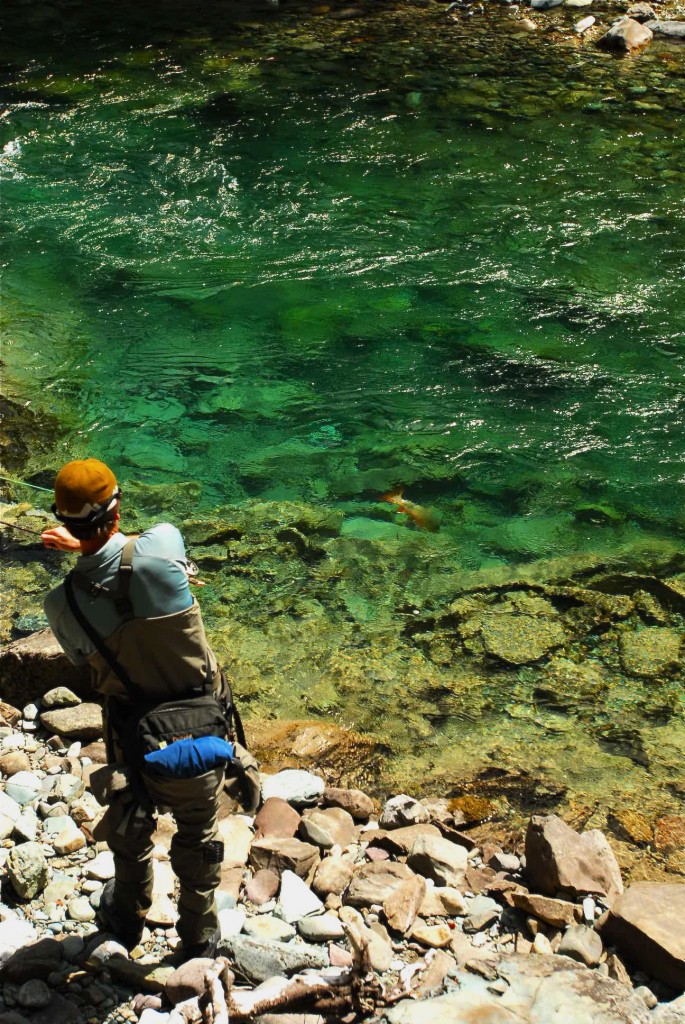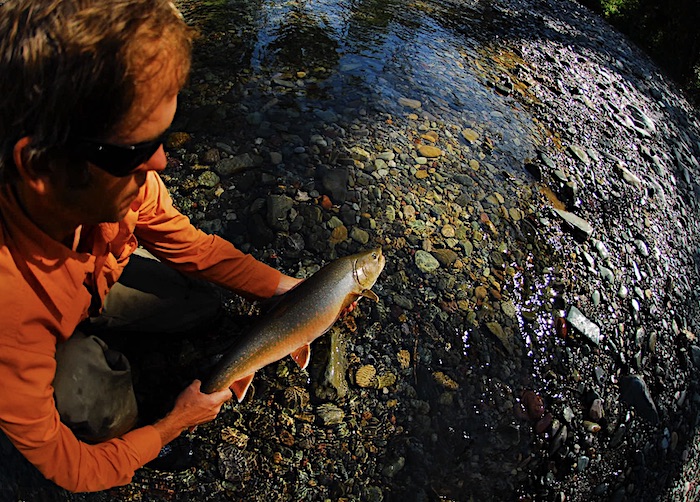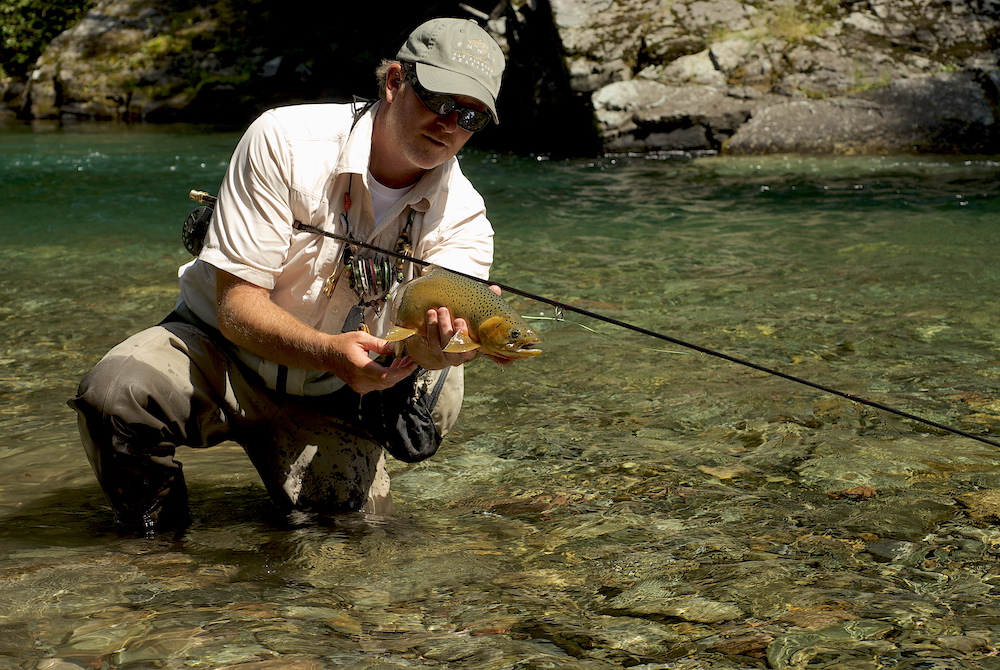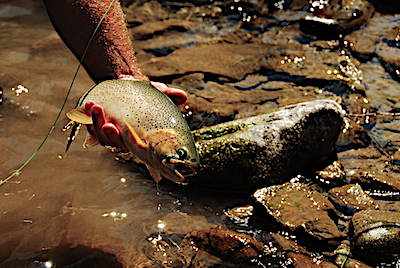 It’s time to start dreaming about the best summer fly fishing trips for 2020, and if we are limited to doing so within our state borders this year, I drew a good card—Montana offers a lifetime of fly-fishing adventure and gas is cheap right now. One of the best Big Sky Country trips you could take is to the South Fork Flathead River in northwest Montana. This river flows through the Bob Marshall Wilderness and is loaded with native westslope cutthroat trout. These aren’t the largest trout you’ll ever see, but they average about 10 inches and stretch up to 17 or 18 inches on the large end. The river also offers bull trout, which can range past 30 inches, and you can legally fish them in this river, if you have a special bull trout permit, which you can buy over the counter. You can’t just say one day, I’m going to fish the South Fork and race up there. Access is via horseback, backpacking, or day hiking into the watershed. Or, you could have horses pack a raft into wilderness and float out. If you choose to do that, make sure you are deft on the oars and know what you are getting into. And, when you’re camping in the Bob Marshall, take all precautions with your food and camp—bears are numerous. Several years ago I headed into the Bob with a pack on my back and a couple friends in tow, and we enjoyed phenomenal fishing on the South Fork. Maybe this is the summer to repeat that trip. Following is a description of that trip, with all the humor and trials thrown in. —GT
It’s time to start dreaming about the best summer fly fishing trips for 2020, and if we are limited to doing so within our state borders this year, I drew a good card—Montana offers a lifetime of fly-fishing adventure and gas is cheap right now. One of the best Big Sky Country trips you could take is to the South Fork Flathead River in northwest Montana. This river flows through the Bob Marshall Wilderness and is loaded with native westslope cutthroat trout. These aren’t the largest trout you’ll ever see, but they average about 10 inches and stretch up to 17 or 18 inches on the large end. The river also offers bull trout, which can range past 30 inches, and you can legally fish them in this river, if you have a special bull trout permit, which you can buy over the counter. You can’t just say one day, I’m going to fish the South Fork and race up there. Access is via horseback, backpacking, or day hiking into the watershed. Or, you could have horses pack a raft into wilderness and float out. If you choose to do that, make sure you are deft on the oars and know what you are getting into. And, when you’re camping in the Bob Marshall, take all precautions with your food and camp—bears are numerous. Several years ago I headed into the Bob with a pack on my back and a couple friends in tow, and we enjoyed phenomenal fishing on the South Fork. Maybe this is the summer to repeat that trip. Following is a description of that trip, with all the humor and trials thrown in. —GT
My forest of fly-fishing friends is thinning. It’s as if some cut-and-run logging company waltzed into Montana and whacked them down at the knees. These days when I propose a fishing trip they are likely to say, “For reasons outside my control, I can’t.” I want them to say, “Where do we meet?” When I hear the former I say, “Who wears the pants in your family?”
We all agree  that finding time to fish is more difficult than it used to be. Time, as our parents promised and we never believed, is at a premium and this comet called life is shifting to overdrive.
that finding time to fish is more difficult than it used to be. Time, as our parents promised and we never believed, is at a premium and this comet called life is shifting to overdrive.
It almost seems like a prerequisite for the fishing trips we take is this: They must be sure-bets so we can strain as much from our time as possible. As I’ve discovered, trout connoisseurs would be hard pressed to find a more secure bet than northwest Montana’s South Fork Flathead River.
The South Fork is a cutthroat-trout laden stream that flows through the pristine, densely forested Bob Marshall Wilderness, a one-million acre chunk of protected turf that offers a quintessential western fly-fishing experience—a level of solitude in wild country with naïve trout taken on nothing more representative than bushy attractor dry flies.
The South Fork, which is located east of Flathead Lake and south of Glacier National Park, is one of three major forks of the mainstem Flathead River. It begins deep in the Bob Marshall and, ultimately, flows more than 40 miles through wilderness designation and another 20 miles through National Forest Service lands before losing itself to Hungry Horse Reservoir.
Throughout, the South Fork Valley is vast and offers a primeval feel. Bull elk, with antlers rubbed chocolate brown on massive cedars and spruce, slip through brushy, huckleberry-bush laden forests. Grizzly and black bears tempt the conscious from their dark, forested lairs, just off the trail and behind camp. Shaggy-maned mountain goats dance across granite cliffs, snubbing their snouts at gravity. Placid, trusting mule deer wander into camp, feeding on meadow grass and wildflowers. Wolverines tromp across shale nine thousand feet above sea-level digging rodents from rock piles, crushing their prey in powerful jaws.
Adding intrigue to a South Fork foray is the method in which anglers access the river—by horseback or on foot, with heavy packs on their backs, following significant trails that course steep bluffs and lead into the wilderness. From numerous promontories, located a couple hundred feet above the South Fork, anglers peer into aqua-green holes, some that reach 30 feet deep, and imagine trout as long as their legs holding against the current.
Unfortunately, all they can do is picture those fish because few monster cutthroats are found in the Flathead. In fact, the South Fork’s trout are mostly modest specimens ranging between six and 14 inches, but 16-inchers are taken with regularity and 17-to 20-inch fish are occasionally landed. Fortunately, anglers atone for that average size in the number of fish landed and they find an overall experience they couldn’t dream of on the big-name streams, such as the Madison, Big Horn, Beaverhead or Yellowstone, where boat-launch lines are common and many fish wear multiple hook scars on their faces.
Take, for instance, a recent trip I took to the South Fork with a couple friends. We started at the Meadow Creek Trailhead on the lower South Fork and charged in about 10 miles, burdened by 50-pound backpacks and the previous evening’s toxic dreams, courtesy of the Bucksnort Bar. We set up camp in a grove of aspens just 30 yards from the stream. A few moments after the tents were erected I cast an obnoxiously large, size-10 Royal Wulff over the current. If I remember correctly, the first cast rose a fish, but I was too startled to set the hook. The next cast brought a fish from bedrock to the top. An explosion occurred at the surface and moments later I twisted a fly from the mouth of an eight-inch cutthroat and set that fish free. Fifteen minutes later I’d released four or five more fish including a 16-inch, solidly built, firm-fleshed specimen. I may have been the first person to handle that fish.
I’m not a numbers guy when it comes to fishing, but I did keep track of the fish I caught on a particular day, August 21. That tally: 43 cutthroats, ranging between six and 17 inches, landed and released; at least 30 more lost via a thrown hook; and another half-dozen trout that leaped over the fly and missed it on the way down, an act that added amusement to a great day on the water.
Between late June and mid-November the river runs so exactingly clear it appears that nothing greater than cellophane exists between the bottom rocks and the sky. Cutthroats levitate for dry flies at a methodical pace that forces anglers to employ every ounce of patience before setting the hook. Trout reward that patience with a few moments of chaos and an occasional aerial display, followed by determined charges to the middle of the river.
Once in hand, anglers find perfection. Remember, cutthroats are the only native trout found in Montana, minus a few smallish rainbows living in the northwest corner of the state. Recall, brown trout came from Europe in the late 1880s and rainbows arrived from California. The native west-slope cutthroats found in the South Fork Flathead are gems, each fish carrying the genes and internal wiring of their ancestors, traits developed specifically for survival in a harsh northern Montana climate and the challenging South Fork Flathead River Valley.
Challenge is a perfect description for the life that South Fork cutthroats lead. Think about it: prior to construction of Hungry Horse Dam in 1953, the South Fork’s cutthroat wintered in Flathead Lake, an act that required a perilous 70-mile downstream journey.
These days, most of the South Fork’s cutthroat descend the river and spend winter in Hungry Horse reservoir, a 35-mile long impoundment that separates the upper South Fork from its lower five miles. In that reservoir the fish find minimal current, which allows them to conserve energy. In addition, they find an adequate winter food supply.
A South Fork cutthroat’s challenges don’t end with winter. During spring those fish move out of Hungry Horse reservoir and into the free-flowing river where they seek relief from high, muddy water and extremely fast flows. Typically they hold behind boulders and downed logs, or in sidechannels where the current is manageable. In doing so, those cutthroats exit prime feeding lanes and set up camp in marginal habitat. In addition, high flows signal a time for mature fish to push upriver and negotiate roily tributary streams, places where they find mates and pea-sized gravel conducive to their spawning effort. That spring activity forces fish to burn severely limited energy reserves and some of them wither.
By July (usually by the Fourth of July), most of the South Fork’s cutthroat have spawned and they return to the main river just as high water recedes. This is when life gets good for the South Fork’s cutthroats and its fly-fishers. At that time the river warms and hatches of stoneflies, caddisflies, mayflies and terrestrial insects, such as ants, beetles and moths occur. During that smorgasbord, cutthroats feed with abandon, pretty much rising to any insect passing overhead, desperately trying to replace lost weight, while building an energy surplus to sustain them through another challenging winter season. By mid-November, when harsh weather returns to northwest Montana, the South Fork’s cutthroat head for the reservoir, hoping they carry enough mass and fat reserves to survive another winter.
That most fish find conditions adequate in Hungry Horse Reservoir is the main reason why the South Fork’s fishery is in better condition that its sister streams, the Middle and North forks of the Flathead River.
Fish from those streams drop to Flathead Lake during winter, just like the South Fork’s fish used to do, where they compete with bull trout and non-native fishes, such as Lake Superior whitefish, lake trout (also called mackinaws), northern pike, and rainbow trout. Lake trout are particularly maddening because they prey heavily on the Flathead system’s cutthroat—in Flathead Lake and in 50 miles of the Flathead River above the lake—which keeps trout populations in the mainstem Flathead and the Middle and North forks much lower than they could and should be.
When fishing the South Fork, anglers can raise fish to bushy, attractor dry flies, such as the classic Royal Wulff. In addition, hair-wing Trudes, Elk-Hair Caddis, Parachute Adams, foam beetles, Humpies, and Renegades rarely meet refusal.
It’s that enthusiasm, that backhand slap to caution, that propensity to crush every fly that floats overhead that, at once, celebrates and sabotages the cutthroat’s reputation. Yes, some anglers say, cutthroats are beautiful fish and they are fun to catch. But, critics add, those fish are “stupid” and offer little challenge to the advanced angler.
The truth is, I respect the cutthroat more than its non-native cousins. I see the cutthroat as a daredevil and a survivor. They live where brown trout and most rainbows can’t. They require of anglers a dedicated effort, a solid hike or a horseback trip to reach. They eat everything in sight because they have to. They’re not stupid. They simply reflect conditions of their environment and if you love the Bob Marshall and wild places where life and death walk a tightrope, you must admire the South Fork cutthroat.
Despite my enthusiasm, some anglers say the South Fork isn’t anything like it used to be, that it’s declined to a point that doesn’t merit their time. In the old days, they say, a guy could catch 20 or 30 cutthroats ranging between 15 and 20 inches a day. Many people attribute the river’s decline to increased angling pressure and likely they are correct. At least three lodges are located outside the wilderness on the lower South Fork and when hiking into the South Fork drainage anglers should expect to encounter private and commercial packtrains, likely several a day. Areas suitable to camping with horses, such as the Big Salmon Lake area, endure serious angling pressure. However, much of the South Fork sees little pressure. Hike-in anglers are free to fish anywhere they please, however far away from the main trails their feet and mindset are willing to take them.
Through the South Fork’s wilderness stretch, anglers are allowed three trout a day, none stretching longer than 12 inches, a limit that ensures good fishing in the future, but not necessarily the fishing of the past. With compliance, anglers could see bigger fish in future years, but don’t count on it. Wilderness is wilderness and enforcement of that regulation is nearly impossible. Some private anglers and even the commercially outfitted groups likely keep fish exceeding the legal size.
 One way to up your odds for a larger fish is to set sights on the South Fork’s other native specie, the bull trout. Until 2004 bull trout were totally protected in the South Fork drainage and directed fishing for them was deemed illegal. Today, fishing for South Fork bull trout, which range to 10 pounds or more, is allowed between the third Saturday in May and August 15. Bull trout are gorgeous, pale-sided, pink-spotted, orange-finned fish that frequent the South Fork’s deepest pools and they are prone to attack streamers, such as double-bunnies, muddler minnows and woolhead sculpins.
One way to up your odds for a larger fish is to set sights on the South Fork’s other native specie, the bull trout. Until 2004 bull trout were totally protected in the South Fork drainage and directed fishing for them was deemed illegal. Today, fishing for South Fork bull trout, which range to 10 pounds or more, is allowed between the third Saturday in May and August 15. Bull trout are gorgeous, pale-sided, pink-spotted, orange-finned fish that frequent the South Fork’s deepest pools and they are prone to attack streamers, such as double-bunnies, muddler minnows and woolhead sculpins.
Overall, the South Fork Flathead is a great trout stream, a place where anglers may expect good fishing, some solitude and gorgeous scenery. It definitely belongs the list of Best Places in Montana to Fish. When the time comes, I’ll take my children to the river and teach them to fish dry flies for eager cutthroats. At camp, likely under phenomenal stars, we’ll stoke a fire, make hot chocolate and toast the Bob Marshall Wilderness. Perhaps in the forest we’ll hear an elk bugle or a wolf howl or a grizzly growl. And, without words, on a calm summer night in Montana we’ll agree that few fly fishing locals offer as much as the South Fork Flathead.


